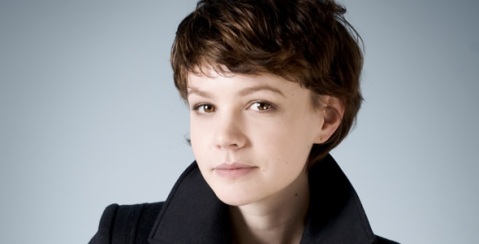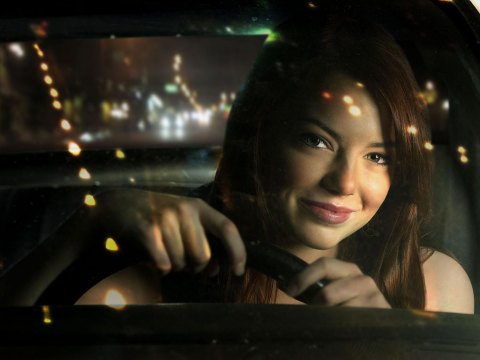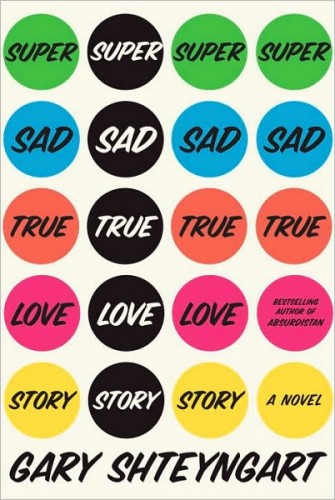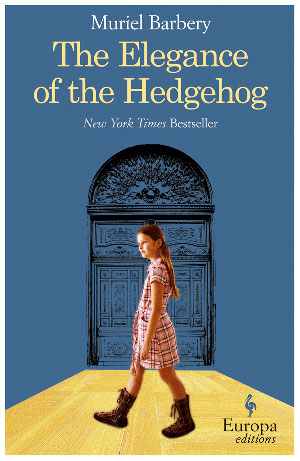Trailer watch: “The Hunger Games” (2012)
6 October 2011
And with that, I’ve got March 23 on my calendar. (Have read the trilogy twice. Just as great the second time through.) It’s nice to know I’ve got something in common with masses of 10- to 13-year-olds everywhere.
For super-fans, I’ll admit I stayed out of the debate over whether Jennifer Lawrence, the much-beloved star of Winter’s Bone and a major player in X-Men: First Class was right for the part of Katniss; I’ve taken a wait-and-see approach. This trailer is very convincing.
“Jane Eyre” (2011): ahhhhh.
28 March 2011
 Mia Wasikowska, the 21-year-old actor who appears in virtually every shot of this beautiful film, is a wonder — and that’s saying a lot. I’ve seen many Jane Eyre adaptations but have always felt that I needed to bring a knowledge of the book to understand the depth of feeling Jane experienced. Whereas in the book we have her narrating her life, it’s hard for actors to convey how much Jane has learned through hard and lonely experience to suppress her feelings, maintain feminine reserve, and quietly inhabit her social rank, at least when with others. Wasikowska, however, has a preternatural capacity to let waves of emotion cross her face while also remaining placid; yet when she allows her true feeling to come forth in words and expression, we see how hard the effort of suppression is — and how much a brilliant mind lies behind that “plain and little” face. Oh my god, it’s amazing.
Mia Wasikowska, the 21-year-old actor who appears in virtually every shot of this beautiful film, is a wonder — and that’s saying a lot. I’ve seen many Jane Eyre adaptations but have always felt that I needed to bring a knowledge of the book to understand the depth of feeling Jane experienced. Whereas in the book we have her narrating her life, it’s hard for actors to convey how much Jane has learned through hard and lonely experience to suppress her feelings, maintain feminine reserve, and quietly inhabit her social rank, at least when with others. Wasikowska, however, has a preternatural capacity to let waves of emotion cross her face while also remaining placid; yet when she allows her true feeling to come forth in words and expression, we see how hard the effort of suppression is — and how much a brilliant mind lies behind that “plain and little” face. Oh my god, it’s amazing.
Here’s what I’ve noticed lately about the serious women actors of her generation (and I leave out the non-serious ones who act in teen comedies): even at their most excellent, they bury themselves so deep in a part that they don’t allow the viewer to see their inner conflicts. Take just two of them who earned so much praise last year (including from me): Jennifer Lawrence of Winter’s Bone and Hailee Steinfeld of True Grit. Their performances were truly excellent, yet between the nature of those roles — which demanded a high degree of stoicism — and the actors’ relative inexperience they ultimately demonstrate an extraordinary degree of actor’s modesty, especially when surrounded by male actors willing to appear far more vivid, fascinating, horrific. As a result, Wasikowska’s actorly range and bravery is amazing. (Not that I’m surprised after watching her on season 1 of In Treatment, which was so amazing I’d watch it all over again even though it’s got to be one of the most painful things I’ve ever seen.)
When I saw the film with my Dear Friend, she complained about Michael Fassbender (above) as Rochester, saying he drew too much attention to himself by using his eyes so much that it undermined the effect of his scenes. She also mentions that it’s hard to understand why Jane loves him (a shortcoming in the book, too, if you ask me) — and I want to suggest that these two things are related. Certainly Fassbender captures Rochester’s hard, bitter edge and the misogyny I always felt was part of his character; why else would he toy with Jane in that ridiculous attempt to make her jealous by flirting with Miss Ingram? My feeling is that Rochester is a tough role that’s too often played more softly as if he’s a romantic hero rather than a reluctant one; in that respect Fassbender does a great job. (It’s worth noting how much Fassbender has a scary propensity to play these slightly misogynistic roles, after his brilliant and somewhat horrifying turn in Fish Tank.)
 More important, I thought the use of his eyes was crucial to the role — and maybe that’s because, for me, the love story is fundamentally about how Rochester truly sees Jane’s inner character, her intelligence, her unexpected strength, her soul. Even though she feels she’s concealing all of it behind that stoic mask she’s learned to wear, Rochester sees early on that she’s exceptional — no wonder the story works so well as a romance (don’t we all want to be seen for our true selves?). I want to suggest that we see through his huge, cruel eyes how much Rochester really doesn’t have control over his feelings, and that he wrestles with his own demons, his own tendency to bury himself in self-pity and hardness rather than open himself up to feeling for others. Jane expresses her emotion through her increasingly visible efforts to suppress it; Rochester expresses it through his increasingly uncontrolled eyes that don’t want to believe there could be such a woman for him. So, Dear Friend, I need a response to this claim!
More important, I thought the use of his eyes was crucial to the role — and maybe that’s because, for me, the love story is fundamentally about how Rochester truly sees Jane’s inner character, her intelligence, her unexpected strength, her soul. Even though she feels she’s concealing all of it behind that stoic mask she’s learned to wear, Rochester sees early on that she’s exceptional — no wonder the story works so well as a romance (don’t we all want to be seen for our true selves?). I want to suggest that we see through his huge, cruel eyes how much Rochester really doesn’t have control over his feelings, and that he wrestles with his own demons, his own tendency to bury himself in self-pity and hardness rather than open himself up to feeling for others. Jane expresses her emotion through her increasingly visible efforts to suppress it; Rochester expresses it through his increasingly uncontrolled eyes that don’t want to believe there could be such a woman for him. So, Dear Friend, I need a response to this claim! 
A final note about Cary Joji Fukunaga’s directing and Moira Buffini’s screenplay, which captured the intensity of gothic horror and the passion of feeling so well. Having loved Fukunaga’s Sin Nombre (2009; and what a different film!) I knew this would be something to see; and it’s no easy feat to wrangle all of a 19th-c. novel into a neat 115 minutes. They achieve it by privileging the central tale of Jane and Rochester rather than her childhood and her time with the Rivers siblings — and I think it’s wholly successful, even for those who haven’t read the book and don’t know the litany of horrors she experiences before coming to Thornfield Hall and meeting Rochester. It never felt Harry Potter-ed, that is, like one of those excessively literal adaptations that labors to hit every key scene of a novel. It was scary, heartbreaking, dark, beautiful, compelling, and I can hardly wait to see it again.
See this film: “Fish Tank” (2009)
27 February 2011
Remember being 15? Everyone seems like such an asshole, and no one’s more of a douche than you. Interactions with your mom amount to screaming matches. Seems like nothing’s going to get better, either. Your hair won’t do what you want and your body’s all over the place — childish in parts and alarmingly womanly in others. Your entire world seems small, stupid. If you’re lucky, you have one thing you’re good at. In Andrea Arnold’s spectacular Fish Tank, Mia (Katie Jarvis)’s one thing is hip-hop dancing. She sneaks upstairs in their depressing council estate flat to an empty apartment, turns on the music, and works on perfecting her moves. I can’t remember seeing a film like this that shows us the world through the eyes of a 15-year-old so intimately — we’re always with Mia, sharing that lonely, locked-in feeling with her, never looking at her. It’s an extraordinary way to put the viewer into a 15-year-old’s head. 
Things shift when suddenly her very young single mother Joanne has a new man in her life — Connor (Michael Fassbender), an Irish guy who just doesn’t fit into the council estate world. He’s so cute, has a middle-class job and a practical man’s car, and expresses such paternal ease and a light touch with Mia and her little sister: what’s he doing with the trashy, foul-mouthed Joanne? And here’s where Arnold captures Mia so perfectly. She doesn’t know whether she wants to flirt with Connor or turn him into the father figure who’d give their lives more stability; she wants both, of course. Because we see everything through Mia’s eyes, we wonder whether Connor is sending mixed signals — and we’re a bit alarmed to realize that we hope he is, even as a sense of unease grows about this seemingly nice guy.
When you’re 15, anything can happen to you — and Mia’s clearly on that precipice. Teenage pregnancy and/or rape are more likely in her precarious world than education or another path to mobility. When she looks at her improbably blonde, half-dressed, alcoholic mother, we know a lot of the venom between them results from the fact that they both know Mia might follow that path too. That’s why her hip-hop dancing is so evocative. It might be private, almost secret, but it gives her power and control over her lanky 15-year-old limbs. Yet being a good dancer gives you no marketable skill. “You dance like a Black,” Connor tells her when he catches her dancing in their miserable little kitchen, she in her pyjamas and he shirtless, unknown. “It’s a compliment,” he clarifies, creating a little bit of confidentiality between them. She scowls, flattered and invaded and attracted. Could dancing be a way out for her? Is she still dancing for herself, or is she dancing for him? When Connor plays Bobby Womack’s haunting, 1960s mellow soul cover of “California Dreamin’,” it means too much to Mia — it becomes their song.
Americans don’t like to watch films about the poor, proclaiming them “depressing,” yet these stories are so real that it seems Katie Jarvis herself is living this life. She had no acting experience when she was discovered for this part fighting with her boyfriend on a train platform. She’d already left school without a diploma, was unemployed, and learned all the dance moves during the filming, giving them a sweet uncertainty. By the time the film was screened at Cannes (where it won the Jury Prize, the first of many awards and nominations for the film) Jarvis was pregnant, limiting her capacity to take more roles.
 When she was interviewed by UK’s The Guardian Jarvis explained her life with telling caution and honesty: “Whereas before I was doing nothing all the time [the film] made me learn that I could do things if I wanted to do it. It was hard, but it was fun and rewarding. Now I want to make the most of it. It shows that you don’t have to go to drama school to get into it, but I think I was one of a kind, I don’t think anyone else will get picked off a train station.”
When she was interviewed by UK’s The Guardian Jarvis explained her life with telling caution and honesty: “Whereas before I was doing nothing all the time [the film] made me learn that I could do things if I wanted to do it. It was hard, but it was fun and rewarding. Now I want to make the most of it. It shows that you don’t have to go to drama school to get into it, but I think I was one of a kind, I don’t think anyone else will get picked off a train station.”
Whether or not she gets more parts, she’s extraordinary in this film, which is easily in my Top Five of last year (it was released in a very limited way in the US in 2010) and one of my favorites of the whole decade. It’s so much better than An Education, which I really liked (see here for A. O. Scott’s reasons for agreeing with this point), and probably even better than Winter’s Bone which I keep singing about. I keep this blog for the hope of seeing films like this and spreading the news about them. It’s streaming on Netflix now — watch it and feel this filmmaker’s amazing vision of what it means to look through the eyes of a 15-year-old. And let’s keep watching for more from Andrea Arnold and Katie Jarvis.
“Winter’s Bone” (2010)
6 July 2010
Poor Timothy Olyphant. While he’s wallowing about as the big fish in the very small pond that is “Justified,” his former “Deadwood” co-stars Garret Dillahunt (who played the psychopathic Mr. W.) and John Hawkes (Sol Starr) have found much richer material in Debra Granik’s wonderful rural thriller, “Winter’s Bone,” based on the Daniel Woodrell novel. Moreover, these actors have delightfully reversed their earlier characters; while Dillahunt now appears as the ineffective but earnest cop, Hawkes no longer offers us his wide blue eyes as in “Deadwood,” but uses his hollow cheeks, broken nose, enormous (and beautiful) hands, and perpetual cigarette to become the terrifying meth-cooking Teardrop, who isn’t quite sure whether he cares enough about his brother’s family to help them escape starvation.
But I digress. This movie belongs to Jennifer Lawrence in the major role of 17-year-old Ree Dolly, whose sole concern is to find a way to keep her family alive. Lawrence appears in virtually every scene — teaching her two younger siblings how to shoot and skin a squirrel, hunting down her father whose disappearance makes it likely they’ll lose their home, hanging laundry, frying potatoes. This is a story about a very young, very smart woman who’s taken on the unenviable job of ensuring that her family survive (not unlike another one of my all-time favorite films, “Fresh”) in the Missouri Ozarks. Moreover, she’s got to accomplish this job amidst the complicated, competing logics of family loyalty and disloyalty, pride in the midst of poverty, and the rules of law and outlaws; it doesn’t occur to her or anyone else that she is a child and shouldn’t have such heavy responsibility. Lawrence plays her role with an extraordinary sureness, even when she’s surrounded by experienced actors like Hawkes whose parts give them the chance to appear more vividly creepy. I fear she’s too subtle an actor to receive the recognition she deserves, as awards so often seem to go to the grandstanders; but she’s sure to add many more nominations to the Best Actress Prize she won at the Seattle Film Festival this year. When she’s getting in a car with someone very scary, she turns to her younger brother and says, “Fry the potatoes till they’re brown and then turn off the stove,” exactly like a big sister would do. She’s multi-tasking — frantically trying to teach her little siblings how they might feed themselves in case things get worse than they already are, at the same time that she’s afraid she really might not come back.
 It’s about time we had a film that showed us true Southern poverty without turning its inhabitants into simplistic rubes or romantic Hollywood versions of “authentic.” I even found myself entering into their own ways of thinking. The characters speak of certain men in the Dolly family with a terrified reverence that verges on myth-making; but slowly one begins to realize that the women possess an equal if not superior capacity for brutality all the scarier because no such reverence for them exists. Family pride is one place where they glean this power. “I’m a Dolly, bred and buttered,” Ree spits at a bail bondsman looking to collect on the debt — and that pride is genuine, even if her family is the heart and soul of her problems. There is no local color, and Lawrence never prettifies herself to ensure a career as the next Lindsay Lohan. This film feels truer than that — and depending on its popularity, might well curb tourist traffic to the Ozarks for years to come.
It’s about time we had a film that showed us true Southern poverty without turning its inhabitants into simplistic rubes or romantic Hollywood versions of “authentic.” I even found myself entering into their own ways of thinking. The characters speak of certain men in the Dolly family with a terrified reverence that verges on myth-making; but slowly one begins to realize that the women possess an equal if not superior capacity for brutality all the scarier because no such reverence for them exists. Family pride is one place where they glean this power. “I’m a Dolly, bred and buttered,” Ree spits at a bail bondsman looking to collect on the debt — and that pride is genuine, even if her family is the heart and soul of her problems. There is no local color, and Lawrence never prettifies herself to ensure a career as the next Lindsay Lohan. This film feels truer than that — and depending on its popularity, might well curb tourist traffic to the Ozarks for years to come.
And then there’s the music, which Granik uses throughout to jar us. Acid metal blurts out of the house of her best friend, now married to a petty patriarch. In another house, a group of old-timey bluegrass musicians play a couple of heartbreakingly lovely classic tunes — but by this time, that music seems so awfully out of touch with the grim realities of life in the Missouri mountains that we’re mostly struck by the disjuncture. Even when Teardrop picks up a banjo and strums it with expert, if rusty, fingers (again, those beautiful hands of Hawkes’), the music comes from left field, always making you realize you don’t know what’s coming next. (Apparently Hawkes has contributed to the forthcoming soundtrack with an instrumental called “Bred and Buttered.) Best of all is a terrific sequence shot at a cattle auction, where Ree is overwhelmed by the sound of the cattle lowing, the auctioneer babbling, animals banging into metal cages. It’s one of those extraordinary true moments onscreen — you have no idea how perfectly such sounds might capture her mood until you see it.
us. Acid metal blurts out of the house of her best friend, now married to a petty patriarch. In another house, a group of old-timey bluegrass musicians play a couple of heartbreakingly lovely classic tunes — but by this time, that music seems so awfully out of touch with the grim realities of life in the Missouri mountains that we’re mostly struck by the disjuncture. Even when Teardrop picks up a banjo and strums it with expert, if rusty, fingers (again, those beautiful hands of Hawkes’), the music comes from left field, always making you realize you don’t know what’s coming next. (Apparently Hawkes has contributed to the forthcoming soundtrack with an instrumental called “Bred and Buttered.) Best of all is a terrific sequence shot at a cattle auction, where Ree is overwhelmed by the sound of the cattle lowing, the auctioneer babbling, animals banging into metal cages. It’s one of those extraordinary true moments onscreen — you have no idea how perfectly such sounds might capture her mood until you see it.
If there’s one thing that motivates everyone equally in Ree’s world, it’s talk. Worse than Ree’s walkabout through the back woods to successively higher-ranked crystal meth dealers as she looks for her father is the resulting gossip about it. At first Ree hopes that word will get around to her father so he’ll come back to help save the house, but it ends up serving the purpose of shaking the bad guys’ trees. Her world hangs on the delicate balance of silence and reputation; thus, talk becomes a weapon far more effective than any other, and Dillahunt’s Sheriff Baskin knows this as well as any of the macho meth kingpins. Not talking is a point of pride for Ree, but this is a political position that only makes sense in an environment where talk can destroy.
Granik keeps her eye on the ball. Another director might pause for a romantic view of the hills or a charmingly dilapidated house, or insist that her characters voice those Southernisms that make a show like “Justified” so obviously designed for outsiders. In contrast, Granik knows this is a film about focusing on the trees — the interpersonal politics and rules of a real community; even the characters’ accents aren’t overdone. When the story really begins to cook into a thriller, you realize how fully you’ve begun to make sense of things on their terms. This is her real accomplishment as a director: to avoid all the pitfalls of Southern stereotypes and Hollywood glamorizing of the rural. Like Lawrence’s tight, perfect performance, Granik’s directing is unembellished while still jolting her viewers as she gradually reveals the truth of the tale. The proof is in the storytelling, and Granik gets it.
Great film. Go see it to get more attention for this little gem.

























 Living outside of New York, LA or Chicago means I haven’t had the chance to see a lot of
Living outside of New York, LA or Chicago means I haven’t had the chance to see a lot of 



 I’ve plunged myself into Muriel Barbery’s wonderful novel, The Elegance of the Hedgehog, which moves back and forth between the interior monologues of two brilliant women: the autodidact Renée, who hides behind her mask as an unkempt, sullen concierge in an elegant Paris apartment building; and Paloma, the precociously intelligent 12-year-old who lives upstairs and despises the pretentions of her family, teachers, and classmates. They seem to be on a path to discover one another — but I’m at the point in the novel when I’m so enjoying just listening to them think out loud that I’m not sure I care whether the narrative goes anywhere (Paloma has a diatribe about why grammar is about accessing the beauty of language that’s so wonderful I’m thinking of plagiarizing it for use in my classes).
I’ve plunged myself into Muriel Barbery’s wonderful novel, The Elegance of the Hedgehog, which moves back and forth between the interior monologues of two brilliant women: the autodidact Renée, who hides behind her mask as an unkempt, sullen concierge in an elegant Paris apartment building; and Paloma, the precociously intelligent 12-year-old who lives upstairs and despises the pretentions of her family, teachers, and classmates. They seem to be on a path to discover one another — but I’m at the point in the novel when I’m so enjoying just listening to them think out loud that I’m not sure I care whether the narrative goes anywhere (Paloma has a diatribe about why grammar is about accessing the beauty of language that’s so wonderful I’m thinking of plagiarizing it for use in my classes).





